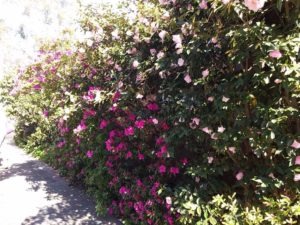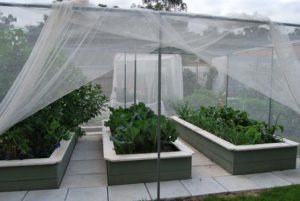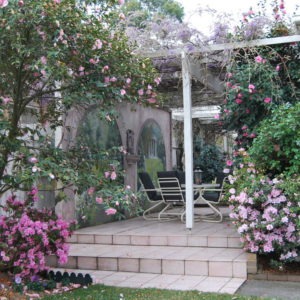This garden is for the soul as well as the stomach – a delight to all the senses. Visually gorgeous in any season, with spectacular camellias in winter through to the cottage-style plantings and roses throughout the rest of year, it is obvious that Valerie gets great delight in having something beautiful to enjoy from the house. Even without the extensive produce, the garden provides colour and interest as well as food.
Valerie moved to this quarter acre block in in Eltham, Victoria, in 1983 with absolutely no gardening experience or knowledge. The house was 1 year old and was built on 7 feet of rock and clay fill. It was very ugly. The decision was to have an English style cottage garden. The neighbours said that it would be impossible. However, the land was rotary hoed, clay breaker (gypsum) and truck loads of good topsoil were brought in. Valerie had tested all the imported soil first before purchasing with a pH testing kit because the ornamentals she wished to grow were acid-loving. Over the last 7 years, the garden has evolved from an all flowering garden to include a range of edibles with organically grown fruit, vegetables and herbs intermingled with flowering plants and trees.
 The drought some years ago caused most of the rhododendrons to die because it became too costly to use the town water for the automatic watering system. A 37,000 litre water tank was then installed to feed an a solar powered irrigation system. It took about a year to have all the downpipes from the house and garage connected to the tank and four connections for hoses installed. It was well worth it.
The drought some years ago caused most of the rhododendrons to die because it became too costly to use the town water for the automatic watering system. A 37,000 litre water tank was then installed to feed an a solar powered irrigation system. It took about a year to have all the downpipes from the house and garage connected to the tank and four connections for hoses installed. It was well worth it.
Over the past five years an elm tree (affected by the elm leaf beetle) and a very large liquid amber tree were removed, amongst other shrubs, to make way for the edible garden. This has resulted in a sunny back yard to take advantage of the fact that the main aspect is facing north-east – a great advantage for growing fruit and vegetables.
 Valerie’s husband, John, is a very good carpenter. First he built the 4 raised vegetable beds and completely netted enclosures for fig and avocado trees. Because so much damage was done by white cabbage moth larvae last year, he erected high enclosures to exclude pests while still having easy access to work in. These enclosures are very sturdy to withstand the test of time.
Valerie’s husband, John, is a very good carpenter. First he built the 4 raised vegetable beds and completely netted enclosures for fig and avocado trees. Because so much damage was done by white cabbage moth larvae last year, he erected high enclosures to exclude pests while still having easy access to work in. These enclosures are very sturdy to withstand the test of time.
The idea of espaliering fruit trees to make good use of available space was very attractive so now they have 10 different espaliered fruit trees, two of which are 2 way trees. These espaliers also serve to create “rooms”. Throughout the garden they have tried to use as many sustainable systems as possible. Heirloom seedlings and seeds are used where available. In the development of the garden they discovered that different plants have different needs, e.g. some require high nitrogen soil content whilst others require less but more potash – so they plant accordingly. They have incorporated worm farms within the vegetable beds, use crop rotation, homemade compost and mulch to provide organic matter to the soil. Blood and Bone and pelleted manure add boost fertility as do the lupins which fix nitrogen.
Snails, slugs, pear and cherry slugs and white cabbage moths seem to be the worst enemies. Coffee grounds and crushed egg shells have been used with some success to keep the snails and slugs at bay.  Careful observation of all plants is a daily habit. Seaweed extract has been a good ally to strengthen plants to help withstand attack and there is an insect hotel and plenty of flowers to attract beneficial insects.
Careful observation of all plants is a daily habit. Seaweed extract has been a good ally to strengthen plants to help withstand attack and there is an insect hotel and plenty of flowers to attract beneficial insects.
They particularly like the fact that there are flowers for all seasons and that it is possible to have beans for 5 months successive plantings. They enjoy picking vegetables when they are required and the really fresh taste of organically grown produce – perfect for John who loves cooking good food with fresh produce. The fruit trees are prolific so that stone fruit can be preserved and enjoyed all year round or made into jam which makes good presents.
All of this is even without mentioning the stunning trompe l’oeuil set off by the wisteria arbour and surrounding shrubs.
A list of the trees and some of the permanent plants within the garden
|
|
|
|
Related Articles:
Companion Planting
Heard about companion planting but don’t know what it is or where to start? This video explores how to use companion plants to improve the health…
Garden Journaling – Slow down to tune in.
As we move through the year and our gardens evolve, there's something magical about documenting the journey. Garden journaling is an art that enables…
Strawberries
I adore strawberries (Fragaria sp.), and one of my earliest memories is a birthday cake absolutely heaving under the weight of a sack full of home…
Climate Resilient Gardening
Introduction Gardeners in Australia are facing a race against time as they experience the growing impact of climate change in their own gardens. The…




